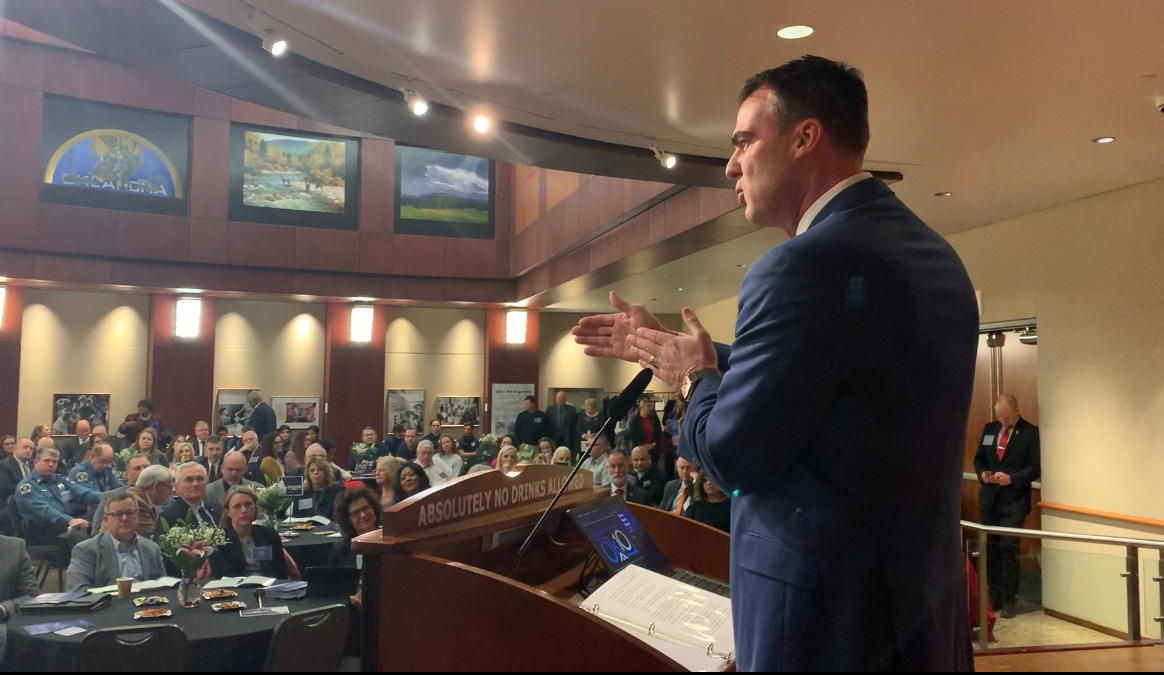ODOC hosts second annual Public Safety Forum; Gov. Stitt, lawmakers, law enforcement and dozens of criminal justice stakeholders attend

OKLAHOMA CITY – Criminal justice stakeholders from across Oklahoma gathered Thursday during the Second Annual Public Safety Forum to discuss issues critical to the future of public safety and criminal justice.
“We’ve got to continue to work together as we try to change our culture,” Stitt told the approximately 170 criminal justice stakeholders assembled at the Oklahoma History Center, noting accomplishments in the state’s recent history-making commutations, transition fairs for inmates, changes to occupational licensing, and establishing a method for inmates nearing release to obtain state IDs or drivers licenses.
“People are seeing what is possible in our state,” Stitt said, before exiting the stage to a standing ovation from the crowd.
Presentations and panel discussions covered a wide variety of topics that expounded on past accomplishments, encouraged discussions and explored new ideas.
“I appreciate and thank everyone who took part in today’s forum,” Crow said. “If we’ve learned anything in Oklahoma over the last year, it is that we must work together and come to a common understanding of our strengths and challenges. In criminal justice, that means all stakeholders must collaborate regardless of differing opinions to make Oklahoma’s justice system more just for all Oklahomans.”
Attorney General Mike Hunter called for more real, verifiable data and facts to inform critical discussions over criminal justice policy and practices.
“At the end of the day, we just want what’s best for the state,” Hunter said, noting that law enforcement wants what’s best for public safety. “That should be our ‘true magnetic north.’”
In a day of insightful presentations and passionate discussions, the highlights of the event were two panels featuring a veritable “who’s who” from a wide variety of experts with stakes in reforming the criminal justice system.
“It is encouraging that we have such incredible staff making DOC the catalyst for positive change as we move Oklahoma toward a top-ten state in criminal justice,” Hastings Siegfried, Chair of the Board of Corrections, said.
Providing the discussion for “Getting to Top 10 – The Future of Criminal Justice” were State Sen. Roger Thompson, R-Okemah, Chair of the Senate Appropriations Committee; Francie Ekwerekwu, Director of the Oklahoma County Pre-Trial Jail Release Initiative through The Employment and Education Ministry (TEEM); Tulsa County District Attorney Steve Kunzweiler; Oklahoma County Chief Public Defender Bob Ravitz; Terri White, Commissioner of the Oklahoma Department of Mental Health and Substance Abuse Services; and Comanche County District Judge Emmit Tayloe.
The second panel discussion from the day, “Improving Outcomes of Criminal Justice-Involved Individuals,” featured Sue Ann Arnall, founder of the Arnall Family Foundation; Mimi Tarrasch, Chief Program Officer, Women in Recovery; Fred Morgan, president and CEO of the State Chamber of Oklahoma; Marcie Mack, Oklahoma Department of Career and Technology Education State Director; Kelly Doyle, Deputy Executive Director for the Center for Employment Opportunities; Clint Castleberry, ODOC Chief of Staff; and Richard McPherson, Executive Director of the Oklahoma Employment Security Commission.
“I want to know the truth,” Arnall said during a break.
Arnall is creating a one-of-a-kind diversion hub in Oklahoma County partnering with law enforcement, the legal community and nonprofits to connect people facing incarceration with services to help them avoid prison.
“I want to know what problems are in the criminal justice system, and who’s being arrested. Is it really addiction? Is it really poverty? Is it really education and employment?”
Illustrating the statistical evolution of criminal justice reform in Oklahoma, Oklahoma Bureau of Narcotics and Dangerous Drugs Research Director Angie Woodrow presented the state’s progress in criminal justice reform. Her analysis showed recent decreases in arrests, criminal filings and inmate population.
Overall, arrests for State Question 780 offenses (including drug possession and property crimes) decreased more than 11 percent from 2015 to 2018.
ODOC Director Scott Crow called the day’s forum a success, and expressed hope that discussions and in-depth collaboration among state and business leaders, agencies and community partners will continue in the best interest of protecting Oklahomans.


